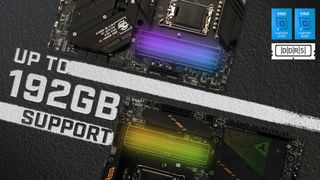MSI on Friday announced that its Intel 600 and 700-series motherboards fully support 24GB and 48GB DDR5 memory modules. As a result, Intel's latest 12th Gen and 13th Generation Core processors can now support up to 192GB of DDR5 memory on MSI's platforms based on Intel's latest chipsets. Other makers of motherboards will likely follow MSI's statement shortly.
Intel's Alder Lake and Raptor Lake CPUs for desktops pack up to 24 cores (8 performance cores, 16 efficiency cores) and can certainly take advantage of more than 128GB of random access memory currently supported by desktop platforms. MSI says it has rigorously tested its MEG, MPG, MAG, and PRO-series motherboards based on Z790, B760, Z690, B660, and H610 chipsets and now states that they are able to use new 24GB and 48GB memory modules.

These motherboards now support 96GB of DDR5 memory, as well as 192GB of memory (for those who want to max out their rig) configurations using four DIMMs. With 192GB of DDR5 SDRAM onboard, every core gets 8GB of memory, which is not bad at all.
Note also that MSI claims that its motherboards support 24GB and 48GB memory modules using existing UEFI versions, so no firmware update is needed. Meanwhile, Intel's own Ark database still states that the company's Alder Lake and Raptor Lake processors (even the recently launched Core i9-13900KS CPU) only support up to 128GB of memory. Perhaps that's because Intel itself has not validated 24GB and 48GB modules across different configurations.
All three leading makers of DRAM have already either formally announced, or at least demonstrated their 24Gb DDR5 memory chips that allow to build the so-called non-binary 24GB and 48GB memory modules. Micron was first to introduce its Crucial-branded 24GB and 48GB DDR5-5200 and DDR5-5600 SDRAM sticks supporting AMD's EXPO and Intel's XMP 3.0 profiles that are aimed at desktops.
Micron's Crucial yet has to start sales of its 24GB and 48GB memory modules in the U.S. (they are currently absent at the official online store), but now that a major motherboard maker has announced support, it's likely we'll see availability of these DIMMs is a matter of weeks.

